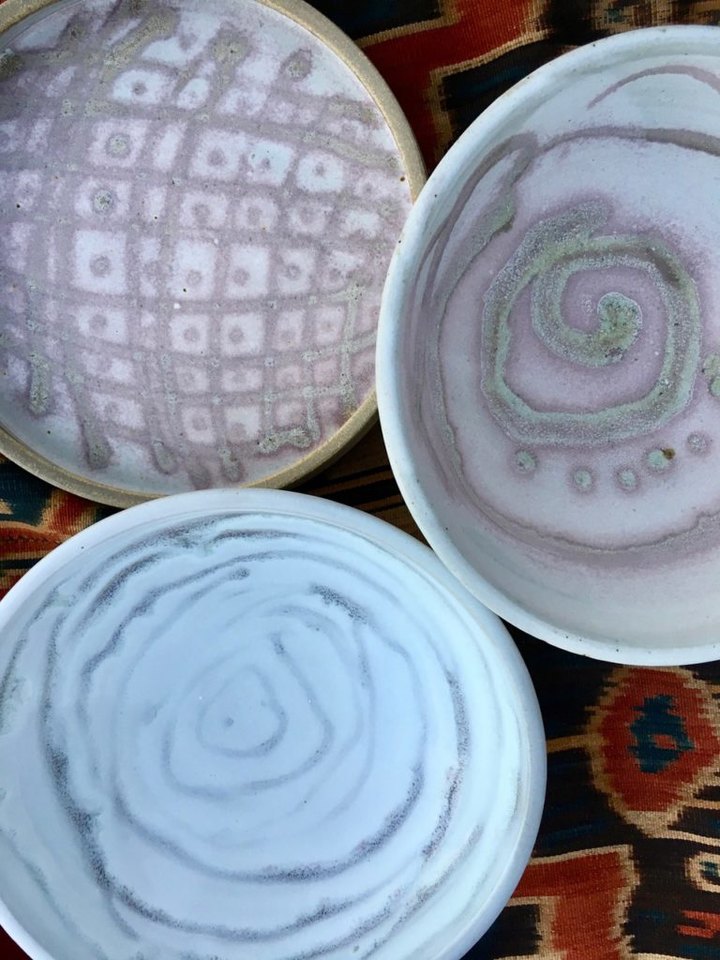Podcast: Play in new window | Download
Bronwyn Clarke | Episode 434

Bronwyn Clarke makes a range of wheel thrown gas fired utilitarian and exhibition pieces from a mix of local, Deep Bay, wild clay, and commercial clays. Bronwyn has developed her own Cone 10 glazes, the colors of which are inspired by the subtle hues of the Tasmanian landscape. Bronwyn is also Chair of The Australian Ceramics Triennale Tasmania 1 – 4 May Hobart, Tasmania, 2019.

SPONSORS

Number 1 brand in America for a reason. Skutt.com

For all your ceramic needs go to Georgies.com

You have had two distinct clay careers from back in the day through today. What changes do you really appreciate about today’s world compared to back then?
I think it’s the technology obviously the way one can control where and how and what work goes to whom. It’s one of those things where I feel a lot closer to my work and to the people who are actually receiving my work. Whereas previously it was just making large amounts of work and the contact was with the seller or the craft shop and the person who was providing. That was the bread and butter kind of work. Now there are certainly opportunities to have work in galleries. I personally am enjoying direct selling my work from the studio.

What do you miss about the old world of ceramics?
There was more contact with the teaching of traditional skills in tertiary educational institutions back in the eighties and nineties. I am not seeing that now. Private tuition in Australia has come to the fore as a result of the loss of accredited vocational education in ceramics. It is a different style of tuition. Sitting down at the wheel and being taught the various skills continuously is not happening these days rather students are doing ceramics as special short design units as part of a more diverse university degree. The teaching of traditional potting skills is the thing I have noticed missing from what is happening in Australia

Do you think you would have gotten back into ceramics had it not been for the community?
I think it is the timing of life, the fact that I have retired from working in the hustle and the bustle of the major cities. There was a choice to come to Tasmania. I think it is a lifestyle attraction that has made my time here very exciting for me. My nature is to seek the community that I would be a part of.

Why are you volunteering for such a big task?
Because over the years I have gained an amazing number of skills. Not just in the potting world but in event management, understanding politics, understanding the value of being entrepreneurial, and it’s not something the majority of potters want anything to do with. I have this conversation and they think I am quite an unusual character that I am prepared to be outgoing and to seek opportunity and to bring opportunity to others if you like. That is the think that has really made me put my hand up. I have all these skills, I would like to use them for the benefit of others.

What do you hope will be the result of this upcoming Triennale?
We are hoping to bring together a wider ceramic community to share and experience all that is current and to encourage the wider community to acknowledge clay making and clay makers, whether they be sculptors or wheel-throwers or writers as a major part of our community and actually create a sustainable income from working with clay. We are having many exhibitions and demonstrations that will be open to the public and we have support from the Tasmania government to assist us in that.

How important is it for potters to study business and business practices?
I believe it is an essential component and one which is avoided because it can be a bit frightening I guess. Sometimes you have this mix of things that happen. If you are seen to be entrepreneurial that can be seen in certain circles as showing off and trying to be better than others. There is a benefit of someone who has prepared to go out and promote and be a part of something. You may have it in your nature but it is a learned skill. If you have a product that is really unique, and every piece of work is for a potter, it is something which needs to be shown to people.

If you could travel anywhere in the world where would you want to go?
I return to Bali of all places every year, if not once, twice. I go there because I can do some throwing and work in the Gaya Ceramic Art Centre there. I have traveled a lot in my younger years but I love the fact that when I’m there I am happy. It is a happiness sensation and it feels like home.

Book

Etched in Fire by Chester Nealie

Contact:
Instagram: @bronwynclarkeceramics

